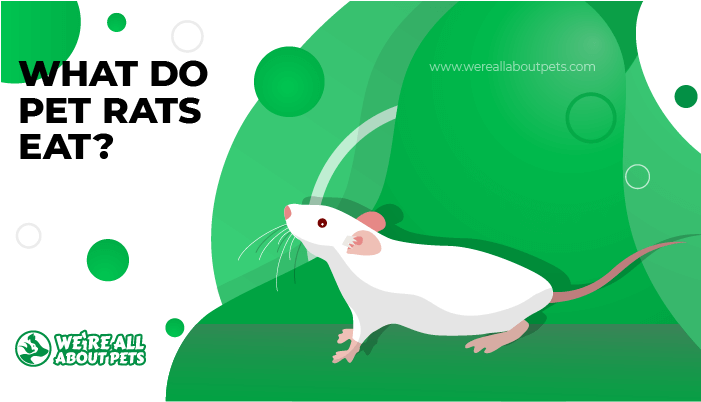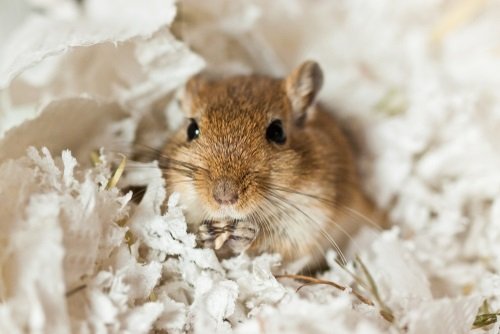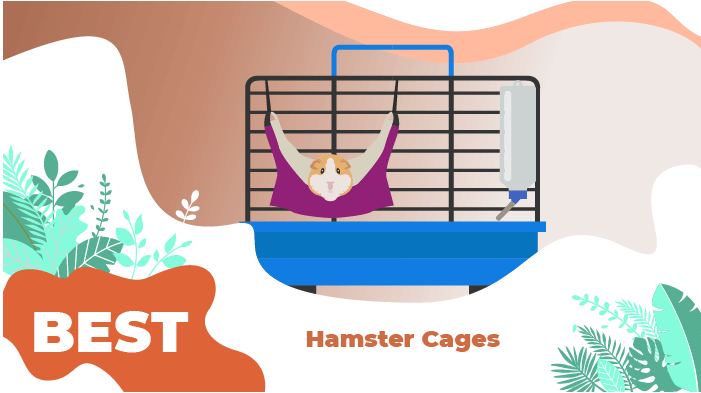What Do Pet Rats Eat?
This page contains affiliate links. We may earn money or products from the companies mentioned in this post through our independently chosen links, which earn us a commission. Learn More

Small pets like rats are a great option if you’re new to pet ownership or you have limited space and time to work with. Rats are surprisingly intelligent, and, despite the rumors, they are actually very clean.
When cared for properly, pet rats can live up to 3 years. The best way to keep your pet rat healthy so you can enjoy its company for as long as possible is to offer it a healthy, balanced diet. In addition to choosing a high-quality commercial rat food, you can offer fresh food and treats – just be careful.
Though your rat might eat just about anything you offer, not all foods that are safe for humans are safe for rats. Read on to learn more about your rat’s nutritional needs and which foods are safe and unsafe.
Safe And Unsafe Foods For Rats
Rats are omnivores by nature which means they eat both plant- and animal-based foods. In captivity, a pet rat generally does best with a staple diet of nutritionally balanced commercial pellets supplemented with fresh foods. Your rat needs specific nutrients to maintain optimal health, just like you do.
Are you wondering what your rat can and can’t eat? To help you learn, we’ve assembled a list of dozens of foods that are and aren’t safe for your pet rat. Check them out below!
15 Foods That Are Safe For Rats:
- Commercial rat food
- Commercial mouse food
- Apples
- Bananas
- Berries
- Broccoli
- Butternut squash
- Carrots
- Cauliflower
- Green beans
- Grapes
- Kale
- Potatoes (cooked)
- Pumpkin
- Whole grains (cooked)
14 Foods Rats Can Eat In Moderation:
- Avocado (no skin or pit)
- Bread (whole-grain)
- Pasta (whole-grain)
- Cheese
- Dog treats
- Dried fruit
- Hardboiled eggs
- Mushrooms (cooked)
- Unsalted seeds
- Unsalted nuts
- Yogurt
- Cooked meat
- Cooked fish
- Dried insects
11 Foods That Are Not Recommended For Rats:
- Hamster food
- Gerbil food
- Guinea pig food
- Fruit pits and seeds
- Sugar
- Salty foods
- Uncooked beans
- Raw cabbage
- Spinach
- Raw potatoes/sweet potatoes
- Wild insects
11 Foods Toxic Or Harmful For Rats:
- Candy
- Chocolate
- Caffeine
- Dried corn
- Potato skins
- Mango
- Onions
- Citrus fruits
- Peanuts
- Poppy seeds
- Green bananas
Understanding which foods are and are not safe for your rat is very important, but you also need to understand your rat’s nutritional needs if you want it to be healthy. Read on to learn the specifics of what to feed your rat at different ages.
Types Of Rat Diets
Providing your pet rat with a healthy and balanced diet is your primary responsibility as a pet owner. Just like you, your rat requires specific nutrients in certain amounts to maintain optimal health and wellness. When shopping for rat food, it’s important to know what you should be looking for.
Here is a quick breakdown of the different components of a pet rat’s diet:
- Balanced Pellets – Nutritionally balanced pellets are the best option for your rat’s staple diet. Look for pellets formulated specifically for mice and rats to ensure the product will meet your rat’s needs without being too high in calories or fat.
- Seed Mixes – Many commercial rodent foods come in this form, but they are generally not the best option for your rat’s staple diet. Choose a high-quality pellet and use small amounts of seed mix to add variety to your rat’s diet. Avoid high-fat seed mixes, if you can.
- Fresh Foods – Fresh fruits and veggies can make up a small portion of your rat’s diet to provide a boost of essential nutrients. Just avoid fruit seeds and pits as well as fruits and veggies that are high in d-limonene (like mango and citrus fruits).
- Treats – You can supplement your pet rat’s diet with treats a few times a week to add variety. Cooked meats and eggs, high-quality dog treats, and cooked grains are good options.
Before moving on, we just want to make a quick note – while pet rats can eat commercial diets formulated for mice, they should not eat food intended for hamsters, gerbils, or guinea pigs.
Rats are omnivorous and while their diet may be similar to hamsters and gerbils, most commercial hamster and gerbil foods are too high in fat for your pet rat. Guinea pigs are herbivores and require a diet comprised primarily of grass hay which won’t provide all the nutrients your rat needs.
Now that you know what kinds of foods will make up your rat’s diet, you’re probably curious to know how much to feed it. Keep reading to learn about feeding recommendations for pet rats.
Meeting Your Pet Rat’s Nutritional Needs
When choosing the right diet for your pet rat, it’s important to consider the rat’s omnivorous nature. Not only do rats prefer to eat a variety of foods, but variety is essential for balanced nutrition.
If you’ve ever shopped for pet rat food before, you’ve probably seen several different kinds. Many inexpensive foods for pet rodents come in the form of seed mixes. These generally consist of colored pellets intermixed with small seeds, nuts, and bits of dried fruit. While your pet rat may like these foods, seed mixes aren’t always the best option because your rat may pick out the foods he likes and leave the rest – this can lead to nutritional deficiencies.
We recommend a nutritionally balanced pellet as the staple of your pet rat’s diet. You should follow the feeding recommendations on the package, but most rats will need 1 to 2 tablespoons of food per day.
In addition to your rat’s staple diet, you’ll want to provide supplemental foods like fresh fruits and veggies, cooked meat and egg, and other treats. Provide these foods in small amounts, about 1 to 2 teaspoons at a time, and try to mix things up. High-fat foods should be offered sparingly, only 2 to 3 times per week, while fresh fruits and veggies can be offered daily.
To give you an idea what and how much you should be feeding your pet rat in different stages of life, refer to this chart:
Daily Rat Feeding Chart |
||||
| Age | Size | Pellets | Veggies and Fruits | Treats |
| 2 to 4 weeks | Baby | Mother’s milk or formula only | ||
| 1 to 6 months | Baby | 1 to 2 tablespoons | 1 to 2 tsp | 2 to 3 times/week |
| 6 months + | Small | 1 to 2 tablespoons | 1 to 2 tsp | 2 to 3 times/week |
Feed your pet rat twice daily and remove uneaten food before adding fresh food. Most rats will eat from a bowl, though some prefer to forage for food in their cage. When feeding pellets or seed mixes, use a small, heavy bowl your rat won’t be able to knock over. Treats and fresh foods can be placed elsewhere in your pet rat’s cage for your pet rat to find.
In addition to your rat’s food, you should provide unlimited access to fresh water. Most rats will drink from a small pet water bottle, so make sure one is hanging in the cage and clean it daily.
Recommended Commercial Rat Foods
Commercial rat food is generally the best option for beginning rat owners. Once you learn the details of your pet rat’s nutritional needs, you may be able to formulate your own diet, if you choose.
When shopping for pet rat food, it’s important to look for a recipe made with high-quality ingredients. Remember, pet rats need a diet with balanced protein, fat, and carbohydrate. Make sure the recipe isn’t too high in fat or calories and check to make sure it has enough protein.
Here are some of our top picks for the best commercial rat food:
- Oxbow Essentials Regal Rat Food – This nutritionally balanced rat food is formulated for adult rats and comes in 3- and 20-pound bags. It provides a rich blend of nutrients without going overboard on fat to help your pet rat maintain a healthy body weight.
- Mazuri Mouse & Rat Food – Formulated for all life stages, this nutritionally balanced rat food is supplemented with high-quality ingredients including omega-3 fatty acids to support your pet’s skin and coat health.
- Vitakraft Complete Nutrition Natural Foraging Blend – If you’re looking for a nutritious way to add variety to your rat’s diet, this foraging blend is a great choice. It consists of nutritionally balanced pellets intermixed with ancient brains, seeds, and veggies.
Choose your pet rat’s diet wisely because it will be the primary source of nutrition. Follow the feeding recommendations on the label to make sure your rat gets the right amount of food daily.
Frequently Asked Questions
What do rats eat in the wild?
Wild rats are omnivores, so they will eat a variety of foods including meat, insects, fruits, vegetables, grains, and more. Pet rats should be offered a varied diet as well.
How much do rats eat?
Pet rats only grow about 9 to 11 inches in length (plus 8 inches tail), so they are not classified as large pets. Most rats will eat about 1 to 2 tablespoons of commercial rat food per day, supplemented with small amounts of fresh foods and treats.
What do rats drink?
Rats drink water, so make sure to provide a small animal bottle with fresh water in your rat’s cage. Clean and refill the bottle on a daily basis.
Do rats eat insects?
Yes, wild rats eat insects as part of their natural diet and pet rats can enjoy them as well. Avoid feeding your pet rat wild insects, however – buy dried insects from the pet store or online. You may want to avoid feeding live insects as well, because they could escape or reproduce in the cage.








